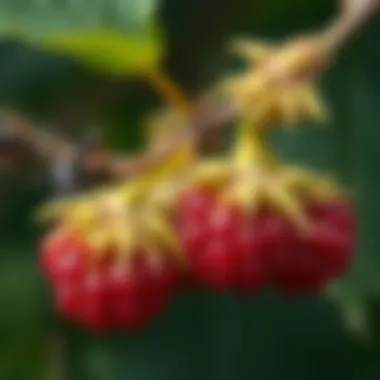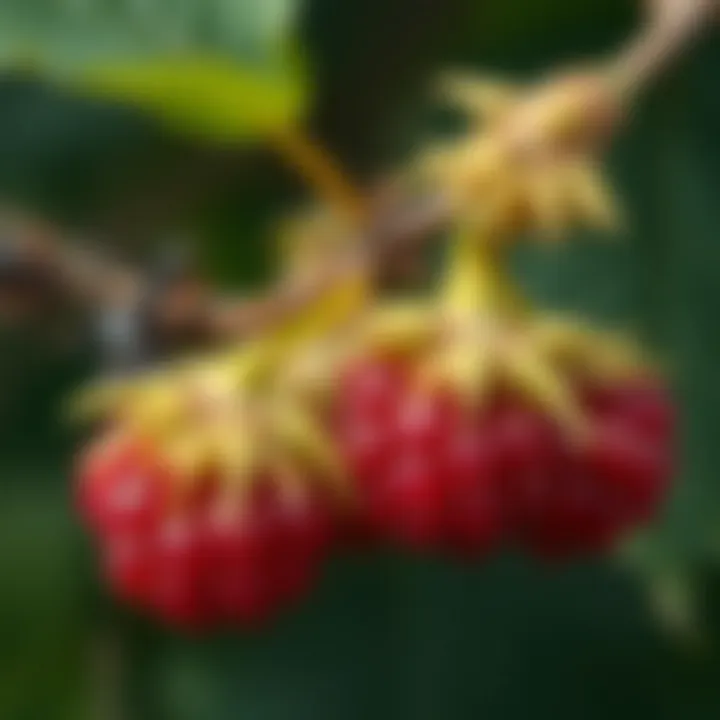Fresh Mulberry Leaves: Nutritional and Health Insights


Intro
Fresh mulberry leaves are often overlooked in discussions about nutrition and health. Yet, these tender green leaves harbor a wealth of benefits that are worthy of attention. People have used mulberry leaves for centuries in various cultures, primarily within traditional herbal medicine. In today’s fast-paced world, their potential is not just limited to nutrition; rather, it extends into agriculture and environmental health as well.
The nutritious profile of mulberry leaves sets them apart from many other leafy greens. They are rich in compounds that can support health, including vitamins, minerals, and antioxidants. As more people turn to plant-based diets, understanding the significance of such greens can pave the way for greater dietary variety and better health outcomes.
In addition to their nutritional value, mulberry leaves contribute positively to soil health, enhancing the ecosystems in which they grow. This exploration seeks to illuminate the multifaceted relevance of fresh mulberry leaves, connecting age-old practices with contemporary scientific findings.
This article will span several critical areas:
- Nutritional Composition
- Health Benefits
- Agricultural Relevance
- Traditional Uses in Herbal Medicine
- Current Research Trends
By delving into these topics, we will appreciate not only the practicality of mulberry leaves in our diets but also their importance in sustainable practices and future research directions.
Preface to Fresh Mulberry Leaves
Fresh mulberry leaves, often overlooked in the modern culinary and nutritional landscape, hold a wealth of benefits waiting to be explored. Understanding their significance invites us to appreciate their multi-faceted roles in health, agriculture, and traditional medicine. This section aims to set the stage for a deeper dive into the nutritional composition, health benefits, and applications of mulberry leaves.
Definition and Overview
Mulberry leaves come from the mulberry tree, a deciduous tree belonging to the Moraceae family. Known scientifically as Morus, the tree's leaves are usually dark green, with a glossy appearance. They are renowned for their use in sericulture, where they serve as the primary diet for silkworms. However, beyond their economic value in silk production, mulberry leaves are rich in various nutrients including protein, fiber, vitamins, and minerals.
People around the world have utilized these leaves for centuries, not only as a food source for livestock but also for their potential health benefits. The leaves can be consumed fresh, dried, or steeped into teas, making them versatile and accessible.
Historical Significance
The historical roots of mulberry leaves extend deep into ancient cultures. For instance, in traditional Chinese medicine, these leaves have been hailed for their cooling properties, believed to balance the body's heat and support respiratory health. In many Asian cultures, mulberry leaves are associated with longevity and vitality.
Additionally, records from ancient Rome suggest the use of mulberry leaves in dietary practices amongst the elite, reflecting their esteemed status. The medicinal properties attributed to mulberry leaves have been documented in various texts, showcasing their significance across cultures and eras. By connecting historical wisdom with modern scientific inquiry, we can better grasp the relevance of mulberry leaves today.
"Mulberry leaves have traveled through time, from ancient remedies to modern kitchens, bridging the gap between tradition and health science."
As we peel back the layers of this unique botanical, we find not only nutrition but a story that weaves through history, culture, and now, scientific exploration. Through the upcoming sections, we will uncover the nutritional value and the critical benefits of fresh mulberry leaves, alongside their application in agricultural practices and culinary innovations.
Nutritional Composition
Examining the nutritional composition of fresh mulberry leaves gives insight into their multifaceted role in human health and environmental sustainability. Mulberry leaves are not just a humble green; they are packed with a spectrum of essential nutrients that can foster better health and well-being. By understanding what they bring to the table nutritionally, one can appreciate their potential applications in everyday life.
Vitamins and Minerals
Mulberry leaves are a treasure trove of vitamins and minerals, vital for various bodily functions. They are particularly rich in Vitamin A, Vitamin C, and Iron. The significance of these nutrients cannot be overstated.
- Vitamin A is crucial for maintaining good vision and a healthy immune system. A single serving of fresh mulberry leaves can contribute significantly to the daily requirements of this vitamin, promoting overall eye health.
- Vitamin C is celebrated for its role in enhancing the immune system and supporting skin health. Fresh mulberry leaves provide ample amounts of this vitamin, making them a beneficial addition to any diet, especially in seasons when colds and flu are rampant.
- Iron is another key mineral found in mulberry leaves, essential for producing hemoglobin, which carries oxygen in the blood. This is particularly important for individuals at risk of anemia or those following a vegetarian diet.
Incorporating mulberry leaves into meals can ensure a steady supply of these vital nutrients. Consider using fresh leaves in salads, smoothies, or as a cooking green. The flexibility in culinary applications helps maintain both nutritional integrity and taste.
"Nutritionally dense foods like fresh mulberry leaves can help bridge gaps in modern diets, especially where traditional foods have fallen out of favor."
Antioxidant Properties
Beyond the basic vitamins and minerals, mulberry leaves are a reservoir of antioxidants. Antioxidants help combat oxidative stress, a condition linked to various chronic diseases and aging.


The leaves contain important compounds such as flavonoids and phenolic acids. These compounds have been shown to play a role in reducing inflammation and potentially lower the risk of conditions like cardiovascular diseases. In simpler terms, the antioxidants present in mulberry leaves can help keep your body in fighting shape against everyday stressors.
Adding markers to the diet that emphasize antioxidants can also be rewarding for those seeking to enhance their overall well-being. Here are some benefits associated with antioxidants in mulberry leaves:
- Anti-Inflammatory Effects: The flavonoids present can help decrease inflammation, which can lead to pain relief and enhanced mobility.
- Cardiovascular Health: Regular intake may contribute to improved heart health, lowering cholesterol levels, and maintaining healthy blood pressure.
- Skin Protection: Due to their antioxidant properties, they can help in skin preservation, making them a potential boon for skincare enthusiasts.
To tap into these benefits, simply adding mulberry leaves to your everyday meals could be a simple but effective strategy. Whether through steeping them in tea or including them in a stir-fry, the possibilities are extensive and beneficial.
Health Benefits
Fresh mulberry leaves carry a wealth of health benefits that are often overlooked. These leaves have gained attention for their potential impact on various aspects of health, particularly metabolic functions and traditional medicinal use. Today, we delve into these aspects while also exploring the merits of these leaves within medicinal practices, both ancient and contemporary.
Impact on Metabolic Health
The relationship between fresh mulberry leaves and metabolic health is quite compelling. Notably, these leaves are touted for their ability to influence blood sugar levels positively. They contain compounds such as 1-Deoxynojirimycin, known to inhibit glucose absorption, which can be particularly beneficial for individuals managing diabetes or those keen on maintaining healthy blood sugar levels. Moreover, these leaves have been shown to facilitate lipid metabolism, aiding in the reduction of harmful cholesterol levels.
Studies indicate that incorporating mulberry leaves into one’s diet may not just be beneficial; it could be a game changer for metabolism. By helping to stabilize blood sugar and promote healthy fat metabolism, fresh mulberry leaves can serve as an adjunctive measure to dietary strategies aimed at metabolic improvement.
Additionally, mulberry leaves are rich in fiber, which plays a crucial role in weight management. A diet high in fiber can lead to increased satiety, ultimately supporting weight loss goals. Including these leaves in meals could provide the necessary fiber boost without compromising taste.
Use in Traditional Medicine
Traditional Remedies
Traditions of using mulberry leaves for medicinal purposes are deeply entrenched in various cultures. In Chinese herbal medicine, mulberry leaves have been praised for their reputed ability to cool the blood and detoxify the body. This attribute has made them a popular choice for addressing ailments ranging from skin issues to respiratory conditions.
A key characteristic of these traditional remedies is their holistic approach to health. Unlike many modern interventions, which may focus narrowly on treating symptoms, mulberry leaves are integrated into broader health strategies. This natural herb has been embraced for its gentle effects, offering a balance rather than a quick fix. The distinct advantage here is that people seeking alternatives to pharmaceutical solutions find mulberry leaves to be accessible and fairly easy to incorporate into their routines, whether brewed as tea or used in culinary applications.
Comparative Analysis with Modern Medicine
When contrasting mulberry leaves with modern medicine, it is essential to appreciate the unique features presented by each approach. Modern medicine often relies on synthetic compounds to treat specific conditions, such as high blood sugar or cholesterol levels. While effective, such solutions may come with a cocktail of side effects, which can deter patients from sticking to their prescribed regimens.
In contrast, incorporating mulberry leaves as a dietary supplement offers a more natural route with fewer adverse effects. Clinical research is beginning to explore these advantages further. The blend of traditional wisdom and modern scientific inquiry promises exciting possibilities for integrating mulberry leaves into holistic health practices.
Ultimately, traditional remedies are gaining traction as complementary approaches within a comprehensive healthcare framework. This merging of old and new can enrich our understanding of health and wellness, highlighting beneficial aspects of mulberry leaves often overlooked in discussions dominated by modern advancements.
The world of fresh mulberry leaves offers a treasure trove of benefits that beckon further exploration.
Armed with this understanding, it is crucial to encourage an ongoing dialogue about their use, fostering a greater appreciation for how these leaves can complement health practices. Engaging more with these traditional remedies not only adds diversity to our health approaches but also opens the door to possibilities informed by both ancient wisdom and contemporary research.
Agricultural Considerations
The role of agricultural considerations in the cultivation of fresh mulberry leaves extends beyond mere farming techniques. It's about understanding how these practices not only benefit the farmer but also contribute to environmental health and sustainability. As we delve into the specific elements, benefits, and nuances of agricultural practices related to mulberry farming, it’s clear that they are integral to maximizing yields and ensuring ecological balance.
Soil Health and Mulberry Cultivation
Benefits to Soil Fertility
Mulberry trees, especially in their younger stages, are known to improve soil fertility. One significant aspect of this is their deep root system which aerates the soil, allowing for better water penetration and root development of other plants nearby. The leaves from mulberry can also be incorporated into the soil as organic matter, enhancing soil structure and overall fertility. This is particularly valuable in areas prone to soil degradation.
The key characteristic of this benefit is the ability of mulberry leaves to decompose and enrich the soil with nutrients like nitrogen, phosphorus, and potassium. Not only does this help in growing healthy mulberry trees, it also supports companion crops, making it a popular choice for farmers looking to improve soil quality.


However, one unique feature worth noting is that while mulberry trees can enhance soil fertility, it's also essential to manage the nutrient intake carefully. Over-fertilization can lead to nutrient runoff, which presents environmental challenges. Hence, it’s crucial for farmers to adopt a balanced approach in mulberry cultivation to reap the full advantages of soil enrichment without unintended consequences.
Crop Rotation Practices
Crop rotation is another key practice that augments the effectiveness of mulberry cultivation. This approach involves alternating the types of crops grown on a particular piece of land to improve soil health and reduce pest and weed pressure. Many farmers incorporate mulberry into their rotation strategies due to its resilient nature and ability to thrive in diverse soil conditions.
The fundamental characteristic of crop rotation with mulberry is its role in breaking the life cycles of pests and diseases that commonly affect crops. This practice fosters a more robust agricultural ecosystem, allowing for the diversification that can protect against total crop failure. Incorporating mulberry as a rotational crop can provide farmers with a natural means to restore nutrient balance in the soil, which often becomes depleted from consecutive plantings of the same crop.
Although crop rotation presents numerous advantages, there are challenges as well. Farmers may initially be hesitant to allocate land to mulberry, as it may take time for these trees to mature and yield benefits. Nonetheless, the long-term gains in soil health and pest management make this a worthwhile strategy in sustainable agriculture.
Pest Management
When it comes to pest management, mulberry leaves play a crucial role. Their natural properties can deter certain pests and also serve as a food source for beneficial insects. For instance, the presence of mulberry can attract predatory insects that feed on common pests, reducing the need for chemical pesticides.
In managing pest populations organically, it’s beneficial to integrate mulberry cultivation with biodiversity strategies in the field. While mulberry may not provide an absolute solution for all pest issues, its inclusion in crop systems offers a holistic approach to maintaining ecological balance and supporting a healthier farm ecosystem.
Culinary Uses
The culinary applications of fresh mulberry leaves provide a fascinating glimpse into their versatility and significance in various gastronomic traditions. These leaves, oftentimes overlooked in favor of the more celebrated fruits of the mulberry tree, can enhance culinary dishes not just through flavor but also through nutritional content. Their inclusion in various cuisines opens doors for creativity while adhering to health-conscious eating practices.
Incorporation in Dishes
Fresh mulberry leaves can be seamlessly integrated into a variety of dishes, appealing to both traditional palettes and modern culinary innovations. These leaves possess a mild, slightly sweet flavor, making them a suitable candidate for salads. For instance, they can be tossed fresh with a mix of other greens, complemented by a zingy vinaigrette for a refreshing starter. In Asian cuisines, particularly in Korean dishes, you can find mulberry leaves being used in wraps alongside grilled meats or spiced vegetables. This not only enhances the flavors but also adds a nutritious crunch.
Moreover, mulberry leaves can be steeped in boiling water to create herbal teas that are both soothing and health-boosting. Those venturing into making soups and stews might experiment by adding mulberry leaves towards the end of the cooking process, allowing their gentle flavor to infuse the dish without overpowering other ingredients. The leaves can also be sautéed quickly with garlic and olive oil, providing a simple yet flavorful side dish.
Potential for Culinary Innovation
The potential for culinary innovation with fresh mulberry leaves is remarkable. As chefs and home cooks alike seek novel ingredients to elevate their dishes, mulberry leaves present a unique opportunity. They can serve as creative alternatives to traditional herbs or greens. For example, think about adding them to pesto recipes instead of basil. The distinct flavor profile can create exciting variations of classic sauces, which can be paired not only with pasta but also as dips for bread.
In recent years, farm-to-table movements have encouraged a resurgence of interest in lesser-known greens. Mulberry leaves could easily capture the attention of those keen on sustainable eating, as they can be grown in diverse climates, contributing to local agriculture. Their incorporation into various innovative dishes can include things like mulberry leaf smoothies, where the health benefits combine with fruit to deliver a refreshing drink.
"Fresh mulberry leaves hold the potential to redefine dietary choices, emphasizing both health and taste in a single ingredient."
As innovators experiment with these leaves, the culinary landscape can shift to include more plant-based options, highlighting their role in modern gastronomy. Furthermore, with health trends leaning towards integrated and holistic eating habits, the incorporation of such leaves can resonate well with those aiming for a balanced diet.
The culinary uses of fresh mulberry leaves underscore their dynamic role not only in traditional dishes but also in pioneering efforts focused on culinary creativity and sustainability. As education on this ingredient spreads, it could potentially carve a niche for itself in kitchens worldwide.
Research Developments and Insights
The significance of fresh mulberry leaves transcends mere culinary uses and nutritional values. In recent years, there has been a growing interest in the research surrounding these leaves, primarily due to their multifaceted applications in health, agriculture, and environmental sustainability. As researchers dig deeper, they uncover insights that challenge conventional wisdom while shedding light on the leaves' extensive benefits. This section examines the latest studies and emerging research trajectories, emphasizing their implications not just for health professionals but for educators, students, and agriculturalists alike.
Current Studies on Mulberry Leaves
Current studies suggest that fresh mulberry leaves possess a wealth of bioactive compounds, including flavonoids, alkaloids, and phenolic acids, all of which contribute to their health benefits. Recent investigations have shown a positive correlation between mulberry leaf consumption and decreased cholesterol levels as well as improved metabolic health. Studies published in reputable journals like The Journal of Medicinal Food highlight the leaves' role in blood glucose regulation, making them an attractive candidate for diabetic management strategies.
"The bioactive components in mulberry leaves are not only numerous, but they might also play a crucial role in addressing chronic diseases." -- Study from the Journal of Medicinal Food
Additionally, research into the potential antioxidant properties of these leaves reveals their capacity to combat oxidative stress, which is linked to various ailments, including cancer and cardiovascular diseases. Scholars have been pioneering studies that explore the leaves' applications in functional foods, hoping to integrate them into daily diets for enhanced nutritional value.
- Key findings from recent studies include:


- Cholesterol-lowering effects seen in hypertensive patients.
- Antidiabetic potential, evidenced by lowered blood sugar levels post-consumption.
- Rich in antioxidants, which could prove significant in cancer prevention strategies.
Future Research Directions
While current studies paint a promising picture, the future of mulberry leaves in scientific research holds even more potential. Researchers are beginning to explore areas that could yield groundbreaking insights into both traditional and modern medicinal practices. One focus is the impact of mulberry leaves on gut health, recognizing that a healthy microbiome is vital for overall well-being. Early research suggests a prebiotic effect, stimulating beneficial gut bacteria.
Another critical area of exploration is the implications of mulberry leaves in sustainable agricultural practices. The leaves' natural pest-repelling properties could be harnessed to reduce chemical pesticide use, aligning with global sustainability efforts.
Future studies might also zero in on the pharmacological properties of mulberry leaves in conjunction with other herbal remedies, exploring synergistic effects. Furthermore, incorporating genetic analyses could illuminate how different cultivation methods and environments affect the nutritional profile of mulberry leaves.
In summary, the ongoing and forthcoming research developments concerning fresh mulberry leaves are significant not just for their applications a health food, but also for agricultural innovation and environmental sustainability. As this field continues to expand, it is evident that mulberry leaves are poised to play an essential role in modern health discussions and sustainable practices across various sectors.
Environmental Impact
The discussion of fresh mulberry leaves wouldn't be complete without considering their environmental impact. This aspect is crucial not only for agricultural practices but also for maintaining an ecological balance. With the rising urgency for sustainable practices in farming and the growing concern over biodiversity, examining how mulberry leaves fit into this puzzle sheds light on their broader significance.
Role in Biodiversity
Fresh mulberry leaves are far more than a food source for silkworms; they play a vital role in the ecosystems where they flourish. These leaves are part of the habitat for numerous species, contributing to local wildlife, including birds and insects.
The following points illustrate their importance:
- Food Source: Mulberry leaves serve as a key nutrient for herbivorous animals and insects, promoting a healthy food web.
- Habitat: The trees themselves provide shelter for various species, thus fostering a diverse environment.
- Pollinator Support: They can also attract pollinators, helping to support the broader environmental cycle.
In areas where these trees dominate, the presence of mulberry can lead to increased species diversity. Countries like China and India have long recognized the integral role of mulberry trees in their agricultural landscapes, with research pointing towards a positive correlation between their cultivation and local biodiversity.
"Healthy ecosystems thrive on diversity, and mulberry leaves contribute significantly to this complexity of life."
Contribution to Sustainable Practices
In the quest for sustainable agriculture, mulberry leaves present an array of benefits. They can be integrated into various practices that promote environmental stewardship. Here are some considerations:
- Soil Enrichment: Mulberry leaves decompose into the soil easily, enriching it with organic matter that improves soil structure and fertility.
- Crop Rotation Compatibility: They can be part of crop rotation cycles, offering a break from monoculture that often depletes soil health.
- Resource Efficiency: With their relatively low water and fertilizer requirements compared to some other crops, mulberries can be cultivated in a more resource-efficient manner.
Adopting mulberry cultivation can aid in creating an agricultural system that supports biodiversity while also addressing the challenges of soil degradation. Farmers are increasingly recognizing that integrating mulberry crops can play a pivotal role in their sustainability efforts.
In summary, the link between fresh mulberry leaves and environmental health is profound. Their role in biodiversity enhances ecosystem stability, while their benefits in sustainable practices position them as a valuable asset in modern agriculture. By understanding and promoting these aspects, we not only elevate the significance of mulberry leaves but also contribute to a more resilient and sustainable agricultural landscape.
The End
The significance of fresh mulberry leaves extends far beyond their culinary appeal or aesthetic presence in gardens. In this article, we explored how these leaves are not just an overlooked component of nature but rather vibrant with potential. Their nutritional richness makes them an excellent choice for health-conscious individuals seeking to enhance their diet. They contain vital vitamins, minerals, and antioxidants, contributing meaningfully to overall health.
Summary of Findings
Surveying the wide-ranging benefits of mulberry leaves reveals several key elements:
- Nutritional Composition: Mulberry leaves are packed with nutrients, including essential vitamins like A, C, and E, along with minerals like calcium and iron. These components are crucial for maintaining various bodily functions.
- Health Benefits: Research indicates mulberry leaves can positively affect metabolic health. They play a significant role in regulating blood sugar levels, which is particularly beneficial for individuals dealing with diabetes.
- Agricultural Relevance: When incorporated into soil health practices, mulberry leaves contribute to increased fertility and enhance pest management strategies. Their ability to improve crop rotation cycles can aid sustainable agricultural methods.
- Role in Traditional Medicine: Historically, mulberry leaves have been used in various cultures for their healing properties. Understanding these applications connects traditional knowledge to modern scientific inquiry.
- Environmental Considerations: By fostering biodiversity and integrating into sustainable farming, mulberry leaves can contribute significantly to ecological health.
Call for Further Exploration
Moving forward, further exploration of fresh mulberry leaves is not merely encouraged; it is essential. As we stand at the intersection of tradition and modern science, unraveling the complexities of this botanical resource could yield revolutionary insights. Here are a few directions for future exploration:
- Clinical Research: More rigorous studies on the health benefits of mulberry leaves should be conducted to validate their medicinal uses and uncover new therapeutic potentials.
- Sustainable Practices: Investigating the role of mulberry in agroecological systems can provide valuable data for farmers looking to adopt sustainable practices.
- Culinary Potential: Experimentation with fresh mulberry leaves in diverse cuisines can unleash a wave of culinary creativity, expanding their usage beyond traditional applications.
"The exploration of mulberry leaves opens doors not just for future food trends but also for enhancing our well-being and sustaining our environment."
As enthusiasm grows and knowledge deepens, fresh mulberry leaves may indeed usher in an era of new possibilities in health, agriculture, and culinary arts. The call for further investigation into their multifaceted benefits is clear, serving as a testament to their captivating nature that warrants our attention.







